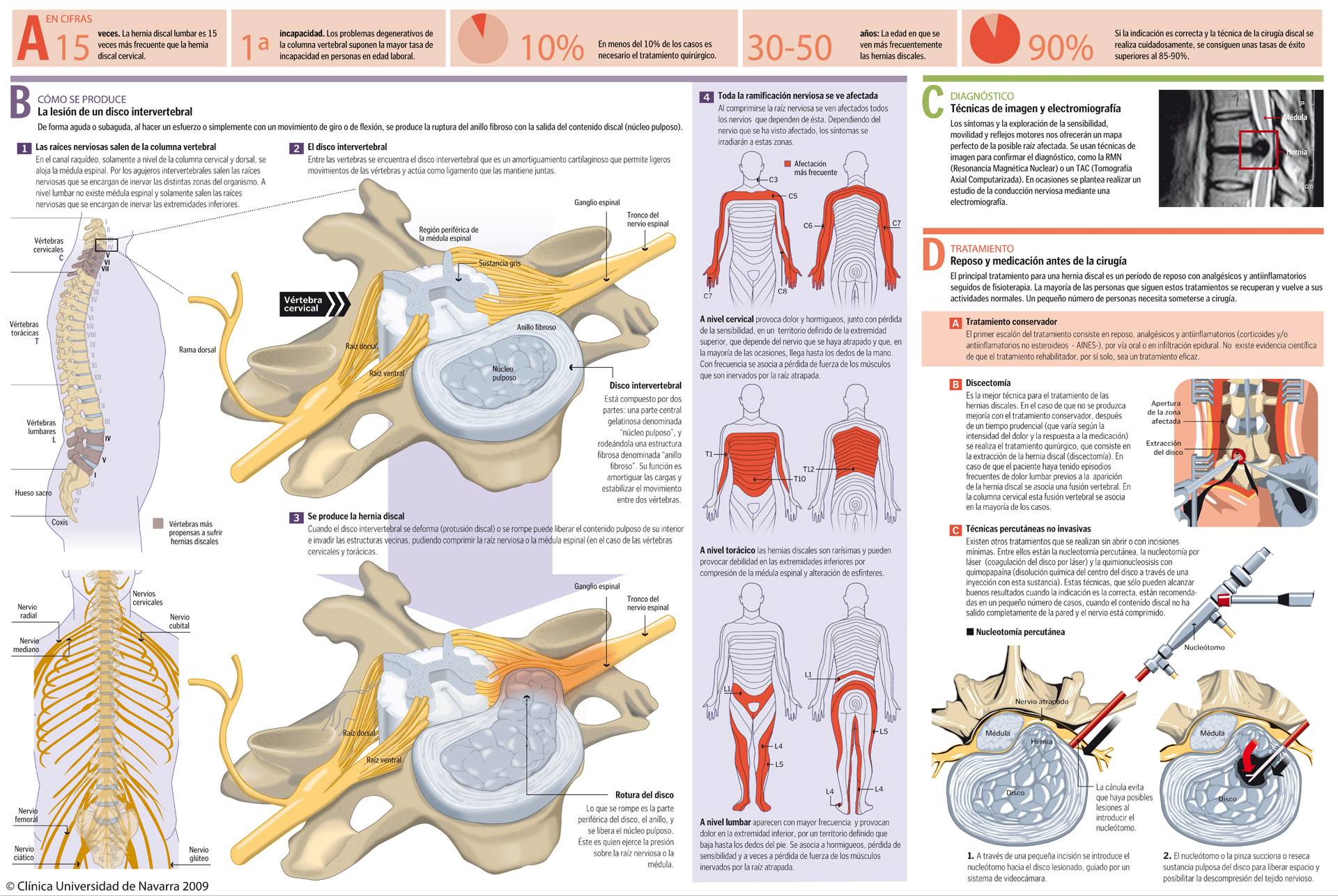Chronic low back pain
"When low back pain appears in a healthy adult from the age of 30 onwards, it is most often due to a degeneration of the intervertebral discs and posterior joints".
DR. EDUARDO HEVIA
SPECIALIST. ORTHOPEDIC SURGERY AND TRAUMATOLOGY DEPARTMENT

Chronic low-back pain is pain that is born in the lower back and persists over time.
Low-back pain can be associated with sciatic pain (compression of the sciatic nerve) or occur in isolation. Most of the population will present or will have presented at some time in their lives some episode of acute low back pain that has lasted between a few hours and several days.
It is a disease that arises from age 40 due to the degeneration of the spine and is the main cause of absenteeism from work and the reasons for consultation in the services of Trauma and Orthopedic Surgery.

What are the symptoms of chronic low back pain?
The main symptom is a persistent pain in the lower back, identified as the back of the waist, which is triggered when standing and improves significantly in bed.
It can also be perceived in the groin area even in genitals and, more frequently, in the back of the buttocks, in the back and side of the thigh and, less frequently, in the calf and side of the leg and in the heel.
The pain is not usually perceived as a current that goes down from the gluteus to the foot, but it appears as patches, "in pieces", in the lower back, in the gluteus and thigh. Difficulty in walking may appear because of the pain in the lower back and lower limb.
Do you have any of these symptoms?
You may have chronic low-back pain
What are the causes of low back pain?
The causes of this syndrome can be many and of varied origin. Anatomically, the chronic lumbar pain can come from the bony and ligamentous structures of the spine (for wear and tear of the posterior articulations or of the intervertebral discs) or of the viscera that surround the lumbar column (kidneys, pancreas).
Others much less frequent are the traumatic ones (vertebral fractures, spondilolisis), metabolic (vertebral fractures by osteoporosis), tumoral, infectious and the acceleration of the evolutionary process of the disc degeneration after a surgical intervention by herniated disc.
The most frequent cause of chronic low back pain is the degeneration of intervertebral discs and posterior joints. This forms part of the normal process of involution that appears in the spine after the age of 20, as occurs in other parts of the body, associated with poor abdominal and lumbar musculature, overweight (which makes the spine work continuously with greater loads for which it is "designed"), and standing for long periods of time and continuous forced postures in lumbar flexion.
What is your prognosis?
It is a chronic disease and the results will depend largely on the physical tone that the patient is able to acquire.
So a patient who is able to lose or maintain an adequate weight, tone the muscles and avoid forced movements of the spine will have a better prognosis than one who is overweight, has a prominent abdomen and low muscle tone.
In the case of having to undergo lumbar fusion surgery, it provides good results with fusion rates greater than 90%, with limited lumbar mobility and a high percentage of patients returning to daily activities, including work.
How is chronic low back pain diagnosed?

The diagnosis of chronic low back pain is made on the basis of the medical history and the physical examination performed by the doctor. It is almost enough to know the symptoms reported by the patient to correctly guide the diagnosis.
The simple x-rays in AP and lateral projection that we carry out are complementary tests and will allow us to rule out other types of pathologies, since the findings that we can find in them (decreased disc height, bone growths on the vertebral margins, scoliosis, etc.) are also seen in patients without any type of low back pain.
Magnetic resonance and TAC or scanner are useful to confirm a disc herniation or other specific pathology when it is suspected by the clinic, but they are of little use in the diagnosis of typical chronic low back pain due to the high frequency of supposedly pathological findings that appear in an asymptomatic population.
How is chronic low back pain treated?
The first step of the treatment is based on:
- Stabilization of the lumbar spine: use of girdles or corsets and toning of the abdominal and spinal muscles (isometric exercises).
- Measures of postural hygiene: ergonomic furniture in the workplace, avoid bending the spine forward and keep the weights close to the body.
- Achieve an adequate weight.
- Anti-inflammatory drugs, both non-steroidal and corticosteroids, analgesics and muscle relaxants can be useful in periods of increased pain.
- Application of currents, massages, tractions and sources of heat in rehabilitation can improve the symptomatology temporarily.
In the following step the periarticular infiltrations of local anesthetic and corticosteroids are included.
In case of improvement with the infiltration and reappearance of the lumbar pain, the percutaneous denervation of the posterior branch, rhizolysis, can be made, that can make remit the symptomatology by a prolonged period of time until in 70% of the cases.
The final step in the treatment of chronic low-back pain is surgery, in which the lumbar spine is stabilized by fixing the affected vertebrae.
This fixation is done with the patient's own bone graft and is facilitated by metal implants such as pedicle screws.
Another valuable option in young people is the disc prosthesis.
Where do we treat it?
IN NAVARRE AND MADRID





